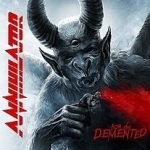
Kids Yogaverse: I AM LOVE
Health & Fitness and Book
App
Kids Yogaverse: I AM LOVE is “Highly recommended” by the US Surgeon General as a healthy app...

Get Resilient! Resilienz-Training mit Hypnose
Health & Fitness and Medical
App
"Get Resilient! Building Resilience by Hypnosis • Develop greater resilience to resist stress and...

Kick Ass Commandos
Games and Entertainment
App
50% OFF LAUNCH DISCOUNT! Lock and Load! It's time to Kick Ass. Grab your machine-gun, flamethrower,...

LOUISE HAY AFFIRMATION MEDITATIONS: ESSENTIAL AFFIRMATIONS FOR HEALTH, LOVE, SUCCESS & SELF-ESTEEM
Lifestyle and Health & Fitness
App
Unleash your full potential for love, health, success and self-esteem with this revolutionary new...
Kirk Bage (1775 KP) rated Eurovision Song Contest: The Story of Fire Saga (2020) in Movies
Aug 6, 2020
Will Ferrell understands this of course. There is so much about the weird world of Eurovision to make fun of. The naff music, the costumes, the lost in translation moments from obscure countries trying their best and mostly failing to realise how daft they look. Enjoying this film depends on how funny you find Ferrell, not on any love of cheesy pop songs. Fortunately, I find him usually hilarious.
Not that every joke lands, or even makes sense at all. It is as bizarre as the contest itself; you just have to leave your brain at the door and go with it. There is a lot to like. Not least the adorable and consistently watchable Rachel McAdams who seems the perfect choice to play Sigrit, the girl dreaming of having the world hear her sing and strive for her spirit note. There is also an odd turn from Pierce Brosnan, who makes no effort whatsoever to make it good, and comes full circle in being so bad it’s amazing.
The joke is that they are from Iceland, who never win the thing, or ever come close. The country itself doesn’t want to win, as they would have to pay for it next year, so, after a bizarre accident where every other candidate explodes, they turn to the naive duo of Fire Saga, who are guaranteed to be a joke. And they are. But of course we are on their side, as they live the dream and go for underdog glory. What can go wrong does, and every comedy trope in the book is trotted out, along with a huge dose of sentimentality.
Naturally there is music. Ranging from the excruciating to the actually not too bad, to the hmmm, I actual like that! One highlight is a montage piece in the middle, as all contestants jam at a pre-final party – just so much fun and a totally catchy song. I am not entirely ashamed to say that it kinda got me. The pathos leading up to the climax hit me in the vulnerable feels, as I lay on a Sunday morning helpfully hung-over and tender. This is the way to watch it, I feel, or, you know, with young kids, who will lap up the silliness and talent show sensibility.
Look, it’s terrible on any artistic or serious level. The script is a mess, the direction could have been phoned in by a chimp, and the plot serves to say nothing new or inciteful, but it doesn’t matter. Watch it, have a chuckle and then throw it away. I can think of many less innocent comedies that are far less worthy of attention. And at the very least, there is a bit with elves that had me pressing pause till I got all my laughs out.
Pick a day when you have no energy to fight the world or string two thoughts together and just enjoy it.
Decinemal Rating: 63
Ivana A. | Diary of Difference (1171 KP) rated Eleven Lines to Somewhere in Books
Oct 2, 2020
Synopsis:
Everyone is searching for love. Sometimes we just take our own route to find it.
Ryan sees a young woman on the tube on his way to work, and he can't stop looking at her. Attracted and intrigued, he's set to find out more about this mysterious passenger that shares the tube with him.
Sylvie keeps travelling the underground, unable to leave for reasons unknown to Ryan. He hasn't been dating for ten years, when he was at university and the love of his life died.
But for some reason, he feels he needs to help Sylvie. In a world of missed opportunities and what-ifs, a connection has been made.
My Thoughts:
This is the second book I have read by Alyson Rudd, with the first one being The First Time Lauren Pailing Died. That book intrigued me, and when I saw Eleven Lines to Somewhere being published - I had to know and compare them.
At the beginning, I was intrigued, knowing what the synopsis is. We meet Ryan and Sylvie (separately), and we get a small glimpse into their lives. In the beginning, Ryan's story with his family and friends is more talked about. I liked getting to know Ryan, very slowly throughout the first half of the book. He is a very intriguing character himself, going through a personal time, as well as making very controversial decisions to get to know Sylvie better.
I liked Sylvie's story and her connection to the underground. It was very intriguing to me to read and understand how some moments in life can let us become something that we can't help but be. That a certain experience can cause such a need for Sylvie to action. I loved the psychological aspect of her characterisation, and how the trauma was handled.
Once Ryan and Sylvie got to know each other, the pace of the book changed, I felt. The pace was very slow, but the scenes moved very quickly in time.
Even though I loved Ryan and Sylvie as separate characters, I couldn't love them as a couple.
I felt that there was chemistry and romance missing, and somehow their connection to each other was based on the need to help the other one with their own trauma. For me, that being a single reason to love someone makes me think a person is in such a relationship to only feel better about themselves. Look - I helped someone, I am a better person now. But that's just my humble opinion.
There were a lot of side characters that had their own storylines - which I really enjoyed. A lot of drama and twists happened with them, which was quite enjoyable to read. Some characters in the end were thrown into the story abruptly, almost as if for convenience to the story line. But it worked well in the end.
I really enjoyed this story. Still a 4 star, but I enjoyed it more than The First Time Lauren Pailing Died. If you love contemporary books with a lot of characters, this will be a very good pick for you!

For the Demented by Annihilator
Album Watch
Annihilator’s brand-new album “For The demented” promises to pack a premier punch....
Metal

Toca Hair Salon 3
Education and Entertainment
App
Welcome to Toca Hair Salon 3! Our most popular app series returns, better than ever! What do you...

My New Roots
Food & Drink and Health & Fitness
App
Cook healthy and delicious food with these 120+ healthy recipes from Sarah Britton’s award-winning...

Kickass Commandos
Games
App Watch
Lock and Load! It's time to Kick Ass. Grab your machine-gun, flamethrower, rocket launcher and...
games

